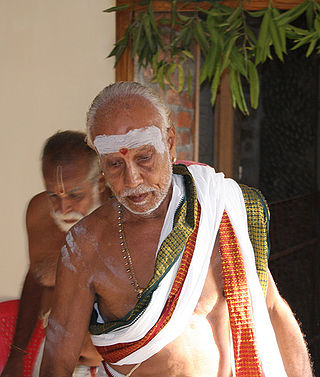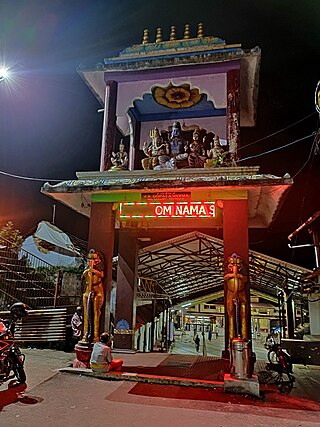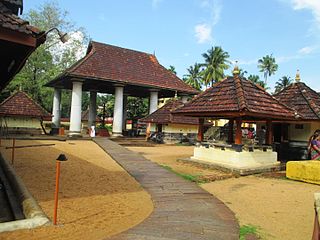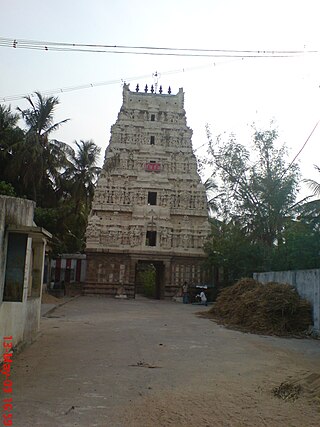
Iyers are an ethnoreligious community of Tamil-speaking Hindu Brahmins. Most Iyers are followers of the Advaita philosophy propounded by Adi Shankara and adhere to the Smarta tradition. This is in contrast to the Iyengar community, who are adherents of Sri Vaishnavism. The Iyers and the Iyengars are together referred to as Tamil Brahmins. The majority of Iyers reside in Tamil Nadu, India.

Valluvanad was an independent chiefdom in present-day central Kerala that held power from the early 12th century to the end of the 18th century. Prior to that, and since the late 10th century, Valluvanad existed as an autonomous chiefdom within the kingdom of the Chera Perumals. The disintegration of the Chera Perumal kingdom in early 12th century led to the independence of the various autonomous chiefdoms of the kingdom, Valluvanad being one of them.

Kalpathi (Kalpathy) Ratholsavam is an annual Hindu Temple festival in the Kalpathy of Palakkad in Kerala state, south India. The festival is at the Sri Visalakshi Sametha Sri Viswanatha Swamy temple where the deities are Lord Siva and his consort Visalakshi, another name for Parvati.
Kizhakkancherry is a gram panchayat in the Palakkad district, state of Kerala, India. It is a local government organisation that serves the villages of Kizhakkencheri-I and Kizhakkencheri-II. It was formed in the year of 1951 and is the fourth largest grama panchayath in Kerala. It covers an area of 112.56 km2 and comprises 22 wards. The boundaries are Vadakkencherry (north), Pananjeri (south), Vandazhy (east) and Kannambra (west). The village is located 37.4 km from the city of Palakkad and 34.9 km from Thrissur.

Palakkad, also known as Palghat, historically known as Palakkattussery, is a city and municipality in the Indian state of Kerala. It is the administrative headquarters of Palakkad District. Palakkad is the most densely populated municipality and the fourth-most densely populated city in the state. It was established before Indian independence under British rule and known by the name Palghat. Palakkad is famous for the ancient Palakkad Fort, which is in the heart of the city and was captured and rebuilt by Hyder Ali in 1766 which later fell into the hands of Zamorin in 1784. The city is about 347 kilometres (216 mi) northeast of the state capital, Thiruvananthapuram.

Chittur-Thathamangalam is a town and municipality in Palakkad district of Kerala State, India. It is the headquarters of Chittur taluk, 13 km (8.1 mi) south-east of Palakkad, on the banks of the Kannadipuzha, a major headstream of the Bharathapuzha, the second longest river in Kerala. A Mini Civil Station is also located here which provides government related services. It consists of two areas, Chittur and Thathamangalam which together form the municipality.

The Nambudiri, also transliterated as Nampoothiri, Nambūdiri, Namboodiri, Namboothiri and Nampūtiri, are a Malayali Brahmin caste, native to what is now the state of Kerala, India, where they constituted part of the traditional feudal elite. Headed by the Azhvanchery Thamprakkal Samrāṭ, the Nambudiris were the highest ranking caste in Kerala. They owned a large portion of the land in the region of Malabar, and together with the Nair monarchs, the Nambudiris formed the landed aristocracy known as the Jenmimar, until the Kerala Land Reforms starting in 1957. Naturalized Tulu Brahmins who took up Nambudiri customary ways are known as Embranthiri Brahmins.

Sri Visalakshi Sametha Sri Viswanatha Swamy temple, popularly known as Kasi Viswanathaswamy Temple, or locally as kundukovil, is a famous Hindu temple located in the Kalpathy village of Palakkad in Kerala, India. It is the site of the annual Kalpathi Ratholsavam which is one of the most famous temple festivals of Kerala. This ancient temple nestles by the banks of the serene Kalpathy river. Dedicate to Lord Siva and his consort Visalakshi, it dates back to early fifteenth century. The similarity to the Varanasi Kashi Viswanatha temple on the banks of Ganges is responsible for the moniker kasiyil pakuthi kalpathy and the name Dakshina Kashi associated with this temple. The Temple is surrounded by the four Tamil Brahmin agraharams or traditional villages: New Kalpathy, Old Kalpathy, Chathapuram and Govindarajapuram.

An Agraharam or Agrahara was a grant of land and royal income from it, typically by a king or a noble family in India, for religious purposes, particularly to Brahmins to maintain temples in that land or a pilgrimage site and to sustain their families. Agraharams were also known as Chaturvedimangalams in ancient times. They were also known as ghatoka, and boya. Agraharams were built and maintained by dynasties such as the Pandya, Cholas, Kadambas, Pallavas, Vijayanagara and other Deccan dynasties since ancient times.
Vadama, meaning "Northerners", are a sub-sect of the Iyer community of Tamil Brahmins. While some believe that their name is an indication of the fact that they were the most recent Brahmin migrants to the Tamil country others interpret the usage of the term "Vadama" as a reference to their strict adherence to the Sanskrit language and Vedic rituals which are of northerly origin.

Tirunavaya Temple is an ancient Hindu temple at Tirunavaya, central Kerala, India, on the northern bank of the Bharatappuzha, dedicated to Navamukundan (Narayana-Vishnu).
Kerala Iyers, Pattars or Bhattars, are Brahmins of the Indian state of Kerala ; people who were residents in the Kerala region. They are Hindus. The community consists of two groups - the Palakkad Iyers and Iyers of the Cochin and Travancore regions.
Nurani is a major commercial and residential area in Palakkad city Kerala, India. It is located along Palakkad Ponnani road which connects further to NH 66.Nurani is ward 39 of Palakkad Municipality. It also contains a heritage village populated mainly by Tamil Brahmins.
Brahacharanam is a sub-sect of the Iyer community of Tamil Brahmins. The word "Brahacharanam" is a corruption of the Sanskrit word Brhatcharanam. Many Brahacharanam follow the Advaita Vedanta philosophy propounded by Adi Shankara. Some Brahacharanam adhere to Shivadvaita. The Brahacharanams, along with the Vadamas, form the major portion of the Kerala Iyer community.

The population of Kerala, India is a heterogenous group that comprises many ethnic groups that originated in other parts of India as well as the world, with distinctive cultural and religious traditions. While the majority of Keralites speak the Malayalam language, various ethnic groups may speak other languages as well.

ThiruvanchikulamSivaTemple is a Hindu temple situated in Kodungallur in Thrissur district of Kerala state, India. Constructed in the Kerala style of architecture, the temple is believed to have been built during the Chera period. Shiva is worshipped as Mahadeva and his consort Parvathi as Umadevi. There are 33 sub-deities in this temple, the highest number so in Kerala.

The Bharathappuzha, also known as the Nila or Ponnani River, is a river in the Indian states of Tamil Nadu and Kerala. With a length of 209 km, it is the second longest river that flows through Kerala after the Periyar. It flows through Palakkad Gap, which is also the largest opening in the Kerala portion of Western Ghats. The Nila has groomed the culture and life of South Malabar part of Kerala. It is also referred to as the "Peraar" in ancient scripts and documents. River Bharathapuzha is an interstate river and lifeline water source for a population residing in four administrative districts, namely Malappuram and Palakkad districts, and parts of Palakkad-Thrissur district border of Kerala and Coimbatore, and Tiruppur of Tamil Nadu. The fertile Thrissur-Ponnani Kole Wetlands lie on its bank.

Anbil Alanthurai Temple is a temple dedicated to Shiva, located on the banks of the Kollidam river in Anbil, a small village near Lalgudi. is a Hindu temple dedicated to Shiva located in the village of Tiruchotruthurai, Tamil Nadu, India. Shiva is worshiped as Sathyavaheeswarar, and is represented by the lingam and his consort Parvati is depicted as Soundaranayagi. The presiding deity is revered in the 7th century Tamil Saiva canonical work, the Tevaram, written by Tamil poet saints known as the nayanars and classified as Paadal Petra Sthalam.
Palakkad district has a large number of temples, churches, mosques and other tourist attractions. Palakkad district is situated in the middle of Kerala state in South India. The nearest airports are at Coimbatore in Tamil Nadu and Cochin in Kerala.

Kalpathy or Kalpathi is a residential area in Palakkad city, Kerala, India. It is famous for the Viswanatha Swamy Temple, which is located along the banks of the Kalpathy river, one of the tributaries of the Bharathapuzha. Kalpathy is also famous for its agraharam, or traditional village. It is the first heritage village in Kerala. There are around 4 agraharams of Brahmins who migrated from Tamil Nadu so many years ago to Kalpathy. Many temples, other than the Viswanatha Swamy Temple, are also present here. The annual festival Kalpathy Ratholsavam is held here, with chariots as the main attraction. Kalpathy and it's neighbourhoods have witnessed large settlements of people in colonies and apartments, making it one of the major residential areas of the city.













